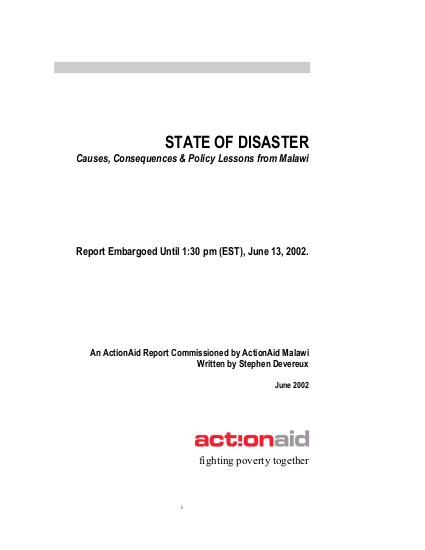
The food crisis in Malawi in early 2002 resulted in several hundred hunger-related deaths – perhaps several thousand. These deaths make this the worst famine in living memory, certainly worse than the drought of 1991/92, and worse even than the Nyasaland famine of 1949. This paper attempts to explain why the famine occurred, and draws lessons for policy interventions to prevent future famines. The famine can be explained in one of two ways. The ‘technical’ view is that bad weather, limited information and import bottlenecks resulted in famine, despite the best efforts of well-intentioned actors. The ‘political’ view attempts to attribute blame: depending on who one talks to, the famine was caused by a callous IMF, profiteering traders, or complacent government and donor officials. The truth lies somewhere in between. The famine was a product of a complex combination of both bad luck and inadequate policies. Following two good production years in 1998/99 and 1999/00, localised floods reduced the 2000/01 maize harvest and left a shortfall estimated at 600,000 MT. However, crop estimates suggested that the maize deficit was partly offset by a 30% increase in roots and tubers production (especially cassava) over the previous year. This figure was wrong and generated misplaced complacency. Donors failed to react to signals of an impending food crisis, the Strategic Grain Reserve was sold, and senior members of government denied the existence of a famine until February 2002, when civil society and the media presented irrefutable evidence of hunger-related deaths. The decision to sell the Strategic Grain Reserve (SGR) followed advice from the IMF to reduce the level of buffer stocks held from 165,000 MT to 60,000 MT. Instead, almost all of the reserve was sold, much of it on local markets, against IMF advice to export it in order to minimise disincentives to maize producers. There is some evidence that much of the SGR was sold to local traders, who stockpiled it and profiteered from hunger. When the government attempted to cover the resulting food gap through imports, this proved extremely expensive, and a series of logistical problems caused fatal delays and an escalation of maize prices to unaffordable levels. Concern about various governance issues – including suspicions of corrupt practice around the SGR sale – caused donors to vacillate for several months before responding to signals of distress with food assistance. These immediate causes of the 2002 famine must be contextualised by explaining the underlying vulnerability factors that left poor Malawians unable to cope with a production shock that was actually less severe than the drought of 1991/92. These ‘vulnerability factors’ included declining soil fertility and restricted access to agricultural inputs during the 1990s; deepening poverty which eradicated asset buffers that the poor could exchange for food to bridge food gaps; the erosion of social capital and informal social support systems in poor communities; the demographic and economic consequences of HIV/AIDS; and the relative neglect over many years of the smallholder agriculture sector. Alarmingly, an FAO/WFP Crop Assessment Mission concluded in May 2002 that the food deficit for the present agricultural year is even larger than last year’s food gap, and with an El Nino event predicted for next year, it is difficult to imagine how rural Malawians can survive three consecutive bad harvests, let alone preserve or rebuild viable livelihoods.